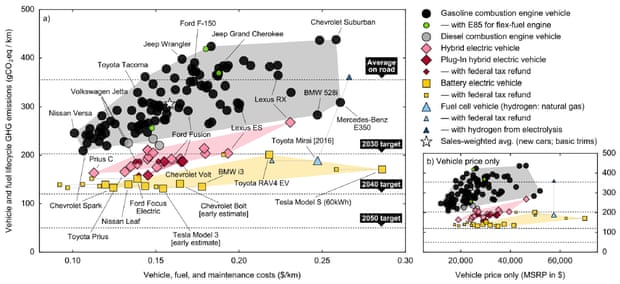
In a new study published in the journal Environmental Science & Technology, with an accompanying app for the public, scientists at MIT compare the carbon pollution from today’s cars to the international 2°C climate target. In order to meet that target, overall emissions need to decline dramatically over the coming decades.
The MIT team compared emissions from 125 electric, hybrid, and gasoline cars to the levels we need to achieve from the transportation sector in 2030, 2040, and 2050 to stay below 2°C global warming. They also looked at the cost efficiency of each car, including vehicle, fuel, and maintenance costs. The bottom line:
Although the average carbon intensity of vehicles sold in 2014 exceeds the climate target for 2030 by more than 50%, we find that most hybrid and battery electric vehicles available today meet this target. By 2050, only electric vehicles supplied with almost completely carbon-free electric power are expected to meet climate-policy targets.

Cost-carbon space for light-duty vehicles, assuming a 14 year lifetime, 12,100 miles driven annually, and an 8% discount rate. Data points show the most popular internal-combustion-engine vehicles (black), hybrid electric vehicles (pink), plug-in hybrid electric vehicles (red), and battery electric vehicles (yellow) in 2014, as well as one of the first fully commercial fuel-cell vehicles (blue). Illustration: Miotti et al. (2016), Environmental Science & Technology.
The MIT app allows consumers to check how their own vehicles – or cars they’re considering purchasing – stack up on the carbon emissions and cost curves. As co-author Jessika Trancik noted,
One goal of the work is to translate climate mitigation scenarios to the level of individual decision-makers who will ultimately be the ones to decide whether or not a clean energy transition occurs (in a market economy, at least). In the case of transportation, private citizens are key decision-makers.
The study used average US fuel and electricity prices over the decade of 2004–2013 (e.g. $3.14 per gallon of gasoline and 12 cents per kilowatt-hour), and the app allows consumers to test different fuel costs. The lifetime of a car is estimated at 14 years and about 170,000 miles. As co-author Marco Miotti explained,
We use parameters that reflect the U.S. consumer experience when going to buy a new car.
As the chart in the lower right corner of the above figure shows, when only accounting for the vehicle purchase cost, gasoline-powered cars are the cheapest. However, hybrid and electric vehicles have lower fuel and regular maintenance costs. In the US, there are also federal rebates that bring the consumer costs down further yet, so the cheapest electric cars (in cost per distance driven) cost less than the cheapest gasoline cars. When including state tax rebates like in California, electric cars are by far the best deal available.
Some might object that it’s unfair to include tax rebates, and the MIT app allows for a comparison with or without those rebates. However, as Trancik noted, the app is aimed at consumers, and for them the rebates are a reality. Moreover, the cost of gasoline in the USA does not reflect the costs inflicted by its carbon pollution via climate change. Over the lifetime of the car, the electric car tax rebates roughly offset the gasoline carbon pollution subsidy. Gasoline combustion releases other pollutants that result in additional societal costs as well.
As the study notes, most of today’s hybrids and plug-in hybrids meet the 2030 climate targets, and electric cars beat them. However, if we’re going to stay below the internationally-accepted ‘danger limit’ of 2°C global warming above pre-industrial temperatures, the US needs to achieve about an 80% cut in emissions by 2050. As co-author Geoffrey Supran noted,
The bottom line is that meeting long-term targets requires simultaneous and comprehensive vehicle electrification and grid decarbonization.
The good news is that we already have the necessary technology available today.Another recent study from MIT’s Trancik Lab found that today’s lowest-cost electric vehicles meet the daily range requirements of 87% of cars on the road, even if they can only recharge once a day. And the technology is quickly advancing; Chevrolet and Tesla will soon release electric cars with 200 mile-per-charge range and before-rebate prices under $40,000. Solar and wind energy prices continue to fall rapidly as well, as we progress toward a “renewable energy revolution.”
Posted by dana1981 on Wednesday, 28 September, 2016
 |
The Skeptical Science website by Skeptical Science is licensed under a Creative Commons Attribution 3.0 Unported License. |